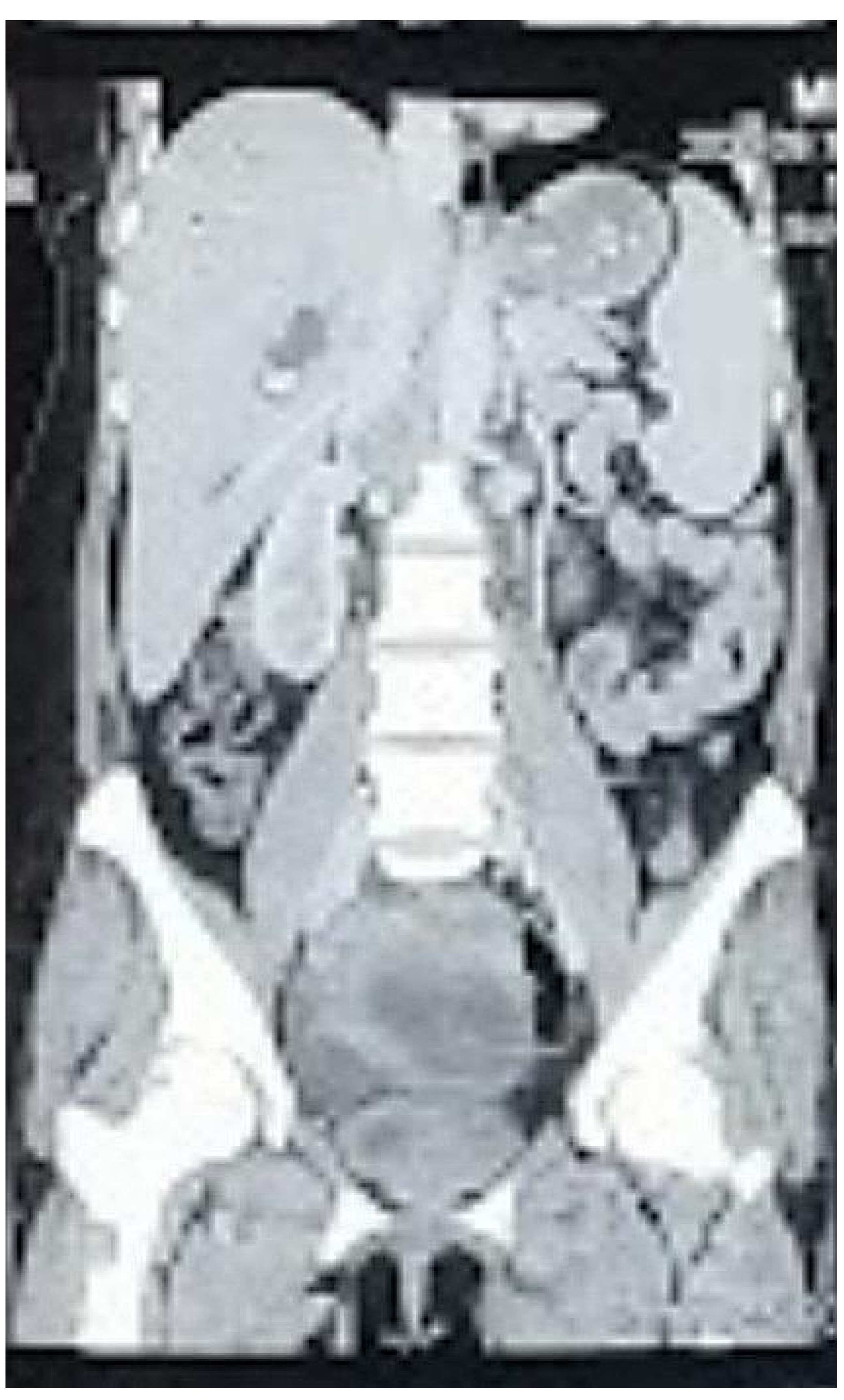Tuesday Poster Session
Category: Biliary/Pancreas
P3603 - Metastasizing Klatskin Tumor to the Ovaries: An Atypical Presentation
Tuesday, October 29, 2024
10:30 AM - 4:00 PM ET
Location: Exhibit Hall E

Has Audio

Anum Khakwani, MD
Charleston Area Medical Center
Winterville, NC
Presenting Author(s)
Anum Khakwani, MD1, Nabeeha Noor, MBBS, MD, BSc.2, Muhammed Murtada. Ceesay, MD3, Muhammad Hassaan. Bashir, MD3
1Charleston Area Medical Center, Winterville, NC; 2Sahiwal Medical College, Wilkes-Barre, PA; 3Charleston Area Medical Center, Charleston, WV
Introduction: Perihilar Cholangiocarcinoma i.e Klatskin tumor usually presents with abdominal pain and painless obstructive jaundice. Metastasis to Liver is common, however, no cases of metastasis to ovaries have been reported yet. This article presents a unique case of Klatskin tumor with ovarian metastasis.
Case Description/Methods: A 35-year-old South Asian woman presented with intermittent lower abdominal pain and constipation for 2 months. Subsequently, she developed colicky right upper quadrant pain, high-grade fever, and clay-colored stools.
On examination, her abdomen was tense, mildly tender, and distended with a palpable mass in the right upper quadrant. Relevant lab derangements included: hemoglobin = 9 g/dl, albumin =2.4 g/dl, and triglycerides =463 mg/dl. Bilirubin was raised to 33.6 mg/dl (direct bilirubin =28.8 mg/dl, indirect bilirubin =4.8 mg/dl). Her inflammatory markers (ESR, CRP) and Ca 19.9 (1335.30 U/mL) were also raised.
USG showed dilated intrahepatic bile ducts and a complex cystic mass extending toward the lower abdomen from the right adnexa. On CT scan, the perihilar mass was causing compression of the portal vein and a large cystic lesion in the left adnexa was also extending into the abdominal cavity. MRCP revealed an obstructive neoplastic lesion with prominent upper retroperitoneal lymph nodes and hepatosplenomegaly. Based on these findings, the provisional diagnosis of klatskin tumor invading the common bile duct was established, and the probable staging was T2N2Mx.
Based on the staging, she was offered chemotherapy, taking an oncologist on board, but she refused any curative therapy.
She underwent a successful ERCP with biliary stenting. She was discharged with advice to follow up with palliative team after 1 week.
Discussion: Klatskin tumor is a rare type of bile duct cancer with an incidence of 1:100,000 per year. It is more common in males in the 6th decade, and most of the cases present with signs and symptoms of obstructive jaundice. However, this was an unusual presentation in a young female with the absence of risk factors.
Surgery continues to be the preferred curative procedure despite the availability of medical and surgical treatments. The optimal therapeutic approach for Klatskin tumor is surgery, with vascular links identified using Oliveira classification. Palliative care is reserved for advanced cases.
This case study emphasizes the importance of increased clinical awareness in detecting unusual presentations in Klatskin tumor.

Disclosures:
Anum Khakwani, MD1, Nabeeha Noor, MBBS, MD, BSc.2, Muhammed Murtada. Ceesay, MD3, Muhammad Hassaan. Bashir, MD3. P3603 - Metastasizing Klatskin Tumor to the Ovaries: An Atypical Presentation, ACG 2024 Annual Scientific Meeting Abstracts. Philadelphia, PA: American College of Gastroenterology.
1Charleston Area Medical Center, Winterville, NC; 2Sahiwal Medical College, Wilkes-Barre, PA; 3Charleston Area Medical Center, Charleston, WV
Introduction: Perihilar Cholangiocarcinoma i.e Klatskin tumor usually presents with abdominal pain and painless obstructive jaundice. Metastasis to Liver is common, however, no cases of metastasis to ovaries have been reported yet. This article presents a unique case of Klatskin tumor with ovarian metastasis.
Case Description/Methods: A 35-year-old South Asian woman presented with intermittent lower abdominal pain and constipation for 2 months. Subsequently, she developed colicky right upper quadrant pain, high-grade fever, and clay-colored stools.
On examination, her abdomen was tense, mildly tender, and distended with a palpable mass in the right upper quadrant. Relevant lab derangements included: hemoglobin = 9 g/dl, albumin =2.4 g/dl, and triglycerides =463 mg/dl. Bilirubin was raised to 33.6 mg/dl (direct bilirubin =28.8 mg/dl, indirect bilirubin =4.8 mg/dl). Her inflammatory markers (ESR, CRP) and Ca 19.9 (1335.30 U/mL) were also raised.
USG showed dilated intrahepatic bile ducts and a complex cystic mass extending toward the lower abdomen from the right adnexa. On CT scan, the perihilar mass was causing compression of the portal vein and a large cystic lesion in the left adnexa was also extending into the abdominal cavity. MRCP revealed an obstructive neoplastic lesion with prominent upper retroperitoneal lymph nodes and hepatosplenomegaly. Based on these findings, the provisional diagnosis of klatskin tumor invading the common bile duct was established, and the probable staging was T2N2Mx.
Based on the staging, she was offered chemotherapy, taking an oncologist on board, but she refused any curative therapy.
She underwent a successful ERCP with biliary stenting. She was discharged with advice to follow up with palliative team after 1 week.
Discussion: Klatskin tumor is a rare type of bile duct cancer with an incidence of 1:100,000 per year. It is more common in males in the 6th decade, and most of the cases present with signs and symptoms of obstructive jaundice. However, this was an unusual presentation in a young female with the absence of risk factors.
Surgery continues to be the preferred curative procedure despite the availability of medical and surgical treatments. The optimal therapeutic approach for Klatskin tumor is surgery, with vascular links identified using Oliveira classification. Palliative care is reserved for advanced cases.
This case study emphasizes the importance of increased clinical awareness in detecting unusual presentations in Klatskin tumor.

Figure: CT scan showing perihilar mass compressing portal vein and a large cystic lesion in the left adnexa extending into the abdominal cavity.
Disclosures:
Anum Khakwani indicated no relevant financial relationships.
Nabeeha Noor indicated no relevant financial relationships.
Muhammed Ceesay indicated no relevant financial relationships.
Muhammad Bashir indicated no relevant financial relationships.
Anum Khakwani, MD1, Nabeeha Noor, MBBS, MD, BSc.2, Muhammed Murtada. Ceesay, MD3, Muhammad Hassaan. Bashir, MD3. P3603 - Metastasizing Klatskin Tumor to the Ovaries: An Atypical Presentation, ACG 2024 Annual Scientific Meeting Abstracts. Philadelphia, PA: American College of Gastroenterology.
